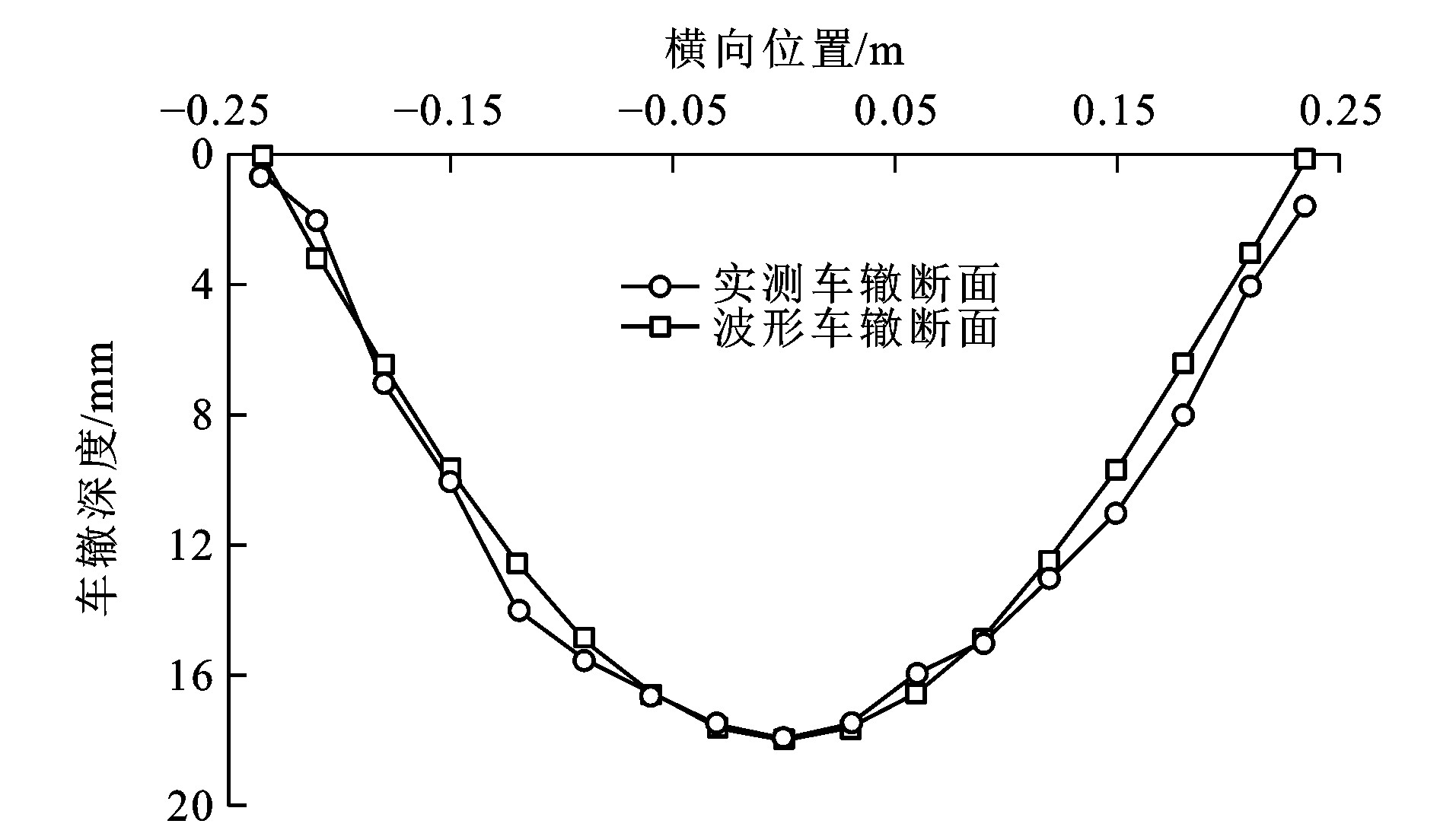Control standards of rut depth based on mechanical behavior of asphalt pavement structure
-
摘要: 为了进一步规范沥青路面车辙深度的控制标准, 研究了车辙深度对路面结构的影响; 考虑车辙断面特征, 建立了车辆跨越车辙时的动荷载计算模型, 并以冲击系数量化了车辆对路面结构的冲击效应; 通过数值仿真研究了车辆荷载作用下路面结构的内部损伤, 探索了不同车辙深度下路面使用性能的衰减规律。研究结果表明: 车辙深度对路面结构的冲击效应不可忽视, 冲击系数随着车辙加深线性增加, 基于冲击效应的车辙深度应不大于11 mm; 沥青混合料层的最大拉应变位于上面层层底, 与车辙深度正相关, 中面层和下面层的拉应变与车辙深度负相关, 但应变水平显著低于上面层, 基于面层弯拉破坏的车辙深度应不大于15 mm; 最大剪应力出现在上面层层底, 随着车辙深度的增加缓慢增大; 车辙深度处于5~10 mm, 各面层的剪应力整体变化较小, 当其从10 mm增加到25 mm时, 上面层0~1 cm深度处的剪应力增加了14.5%, 增速明显超过中面层和下面层剪应力的减小速度, 基于面层剪切破坏的车辙深度应不大于10 mm; 车辙深度对无机结合料稳定层拉应力的影响不大; 车辙深度超过15 mm后应关注路基顶面压应变的变化, 防止路基出现大的变形。Abstract: In order to further regulate the control standards of rut depth of asphalt pavement, the influence of the rut depth on the pavement structure was studied. A dynamic load calculation model of vehicle crossing the rut was established based on considering the characteristics of rut cross section, and the vehicle impact effect on the pavement structure was quantified by impact factor. The inner damage of pavement structure was studied by numerical simulation, and the degradation laws of pavement performance at different rut depths were explored. Research result shows that the impact effect of rut depth on the pavement structure cannot be ignored. The impact factor increases linearly with rut depth, and the allowable rut depth considering the impact effect should not be greater than 11 mm. The maximum tensile strain of asphalt mixture layer appears at the bottom of the upper surface layer and is positively correlated with the rut depth. While the tensile strains of the middle surface layer and lower surface layer are negatively correlated with rut depth, and their strain levels are significantly lower than that of upper surface layer. The rut depth based on the surface layer flexural failure should be less than 15 mm. The maximum shear stress appears at the bottom of the upper layer and increases gradually with rut depth. When the rut depth is between 5-10 mm, the shear stress of each surface layer changes little. When the rut depth develops from 10 mm to 25 mm, the shear stress at 0-1 cm depth of the upper layer increases by 14.5%, which is obviously faster than the decreasing rate of shear stress of the middle layer and lower layer. Thus, the rut depth based on the surface layer shear failure should be less than 10 mm. The rut depth has little influence on the tensile stress of inorganic binder stable layer. When the rut depth exceeds 15 mm, the change of compression strain on the top of subgrade should be focused to prevent large deformation.
-
表 1 实测车辙断面数据
Table 1. Measured rut section data
车辙断面左侧距离/m -0.235 -0.210 -0.180 -0.150 -0.120 -0.090 -0.060 -0.030 0 左侧车辙深度/mm 0.5 2.0 7.0 1.0 14.0 15.5 16.5 17.5 18.0 车辙断面右侧距离/m 0 0.030 0.060 0.090 0.120 0.150 0.180 0.210 0.235 右侧车辙深度/mm 18.0 17.5 16.0 15.0 13.0 11.0 8.0 4.0 1.5 表 2 路面材料参数
Table 2. Material parameters of pavement
材料 温度/℃ 蠕变参数 弹性参数 A m n 回弹模量/MPa 泊松比 SMA-13 40 1.45×10-8 0.792 -0.577 554 0.35 Superpave-20 36 2.30×10-8 0.782 -0.576 661 0.35 Superpave-25 32 9.31×10-9 0.791 -0.582 862 0.30 水泥稳定碎石 20 — — — 1 200 0.20 级配碎石 20 — — — 500 0.30 土基 20 — — — 45 0.40 -
[1] 姚玉玲, 李学红, 张毕超. 沥青路面预防性养护时机综合评价指标体系[J]. 交通运输工程学报, 2007, 7(5): 48-53. doi: 10.3321/j.issn:1671-1637.2007.05.011YAO Yu-ling, LI Xue-hong, ZHANG Bi-chao. Integrative evaluation index system for preventive maintenance timing of asphalt pavement[J]. Journal of Traffic and Transportation Engineering, 2007, 7(5): 48-53. (in Chinese). doi: 10.3321/j.issn:1671-1637.2007.05.011 [2] GARY HICKS R, MOULTHROP J S, DALEIDEN J. Selecting a preventive maintenance treatment for flexible pavements[J]. Transportation Research Record, 1999(1680): 1-12. [3] ONG G P, FWA T F. Wet-pavement hydroplaning risk and skid resistance: modeling[J]. Journal of Transportation Engineering, 2007, 133(10): 590-598. doi: 10.1061/(ASCE)0733-947X(2007)133:10(590) [4] ZHU Xing-yi, PANG Ya-feng, YANG Jian, et al. Numerical analysis of hydroplaning behaviour by using a tire-water-film-runway model[J]. International Journal of Pavement Engineering, 2020(11): 1-17. [5] 徐世法. 沥青路面的车辙深度与行车安全性[J]. 北京建筑工程学院学报, 1994, 10(1): 47-51. https://www.cnki.com.cn/Article/CJFDTOTAL-BJJZ199401006.htmXU Shi-fa. Pavement rutting depth related to vehicle travel safety[J]. Journal of Beijing Institute of Civil Engineering and Architecture, 1994, 10(1): 47-51. (in Chinese). https://www.cnki.com.cn/Article/CJFDTOTAL-BJJZ199401006.htm [6] FWA T F, PASINDU H R, ONG G P. Critical rut depth for pavement maintenance based on vehicle skidding and hydroplaning consideration[J]. Journal of Transportation Engineering, 2012, 138(4): 423-429. doi: 10.1061/(ASCE)TE.1943-5436.0000336 [7] LIU Xiu-yu, CAO Qing-qing, CHEN Jia-ying, et al. Simulation of vehicle braking behavior on wet asphalt pavement based on tire hydroplaning and frictional energy dissipation[J]. Journal of Southeast University (English Edition), 2018, 34(4): 500-507. [8] GUO Xin-xin, ZHOU Bo-wen, ZHANG Chi. Analysis of rutting index for pavement maintenance based on driving safety on surface gathered water consideration[C]//COTA. 14th COTA International Conference of Transportation Professionals: Safe, Smart, and Sustainable Multimodal Transportation Systems. Beijing: COTA, 2014: 909-918. [9] CHEN Lei-lei, LIU Gang, QIAN Zhen-dong, et al. Determination of allowable rutting depth based on driving safety analysis[J]. Journal of Transportation Engineering, Part B: Pavements, 2020, 146(2): 04020023-1-9. [10] 丛菱, 杨军. 基于车-路系统动力学仿真的车辙深度控制标准[J]. 工程力学, 2010, 27(11): 191-195. https://www.cnki.com.cn/Article/CJFDTOTAL-GCLX201011030.htmCONG Ling, YANG Jun. Control standard for rut depth based on simulation of vehicle-pavement system dynamics[J]. Engineering Mechanics, 2010, 27(11): 191-195. (in Chinese). https://www.cnki.com.cn/Article/CJFDTOTAL-GCLX201011030.htm [11] 徐暘. 基于行车安全的沥青路面车辙研究[D]. 长沙: 中南大学, 2011.XU Yang. Research on asphalt pavement rut based on traffic safety[D]. Changsha: Central South University, 2011. (in Chinese). [12] 丁勇, 黄奇, 区光达, 等. 基于分布式弹簧-阻尼单元的桥头跳车动力荷载分析[J]. 土木工程学报, 2012, 45(12): 127-135. https://www.cnki.com.cn/Article/CJFDTOTAL-TMGC201212015.htmDING Yong, HUANG Qi, OU Guang-da, et al. Analysis of dynamic load of vehicle bumping at bridge-head using distributed spring-damper element[J]. China Civil Engineering Journal, 2012, 45(12): 127-135. (in Chinese). https://www.cnki.com.cn/Article/CJFDTOTAL-TMGC201212015.htm [13] 陶向华. 路桥过渡段差异沉降控制标准与人车路相互作用[D]. 南京: 东南大学, 2006.TAO Xiang-hua. Differential settlement control criterion of bridge-approach and people-vehicle-road interaction[D]. Nanjing: Southeast University, 2006. (in Chinese). [14] CHELI F, BRAGHIN F, BRUSAROSCO M, et al. Design and testing of an innovative measurement device for tyre-road contact forces[J]. Mechanical Systems and Signal Processing, 2011, 25(6): 1956-1972. doi: 10.1016/j.ymssp.2011.02.021 [15] 田文泽. 基于多指标的车辙评价标准研究[J]. 交通科技, 2011, 246(3): 77-79. doi: 10.3963/j.issn.1671-7570.2011.03.025TIAN Wen-ze. Research on rut evaluation standards based on multiple indexes[J]. Transportation Science and Technology, 2011, 246(3): 77-79. (in Chinese). doi: 10.3963/j.issn.1671-7570.2011.03.025 [16] SIMPSON A L. Characterization of transverse profile[J]. Transportation Research Record, 1999(1655): 185-191. [17] KAZUYA T, AKIRA K, TATSUO S. Study on the modeling method suitable for pavement rutting[J]. Journal of Applied Computing in Civil Engineering, 2006, 15: 287-296. doi: 10.2208/journalac2003.15.0_287 [18] 徐建平, 尚刚, 梁乃兴. 路面不平整引起的汽车动荷载计算分析[J]. 重庆交通学院学报, 2001, 20(1): 26-28. doi: 10.3969/j.issn.1674-0696.2001.01.007XU Jian-ping, SHANG Gang, LIANG Nai-xing. Analysis of dynamic load caused by driving automobile on undulate pavement[J]. Journal of Chongqing Jiaotong University, 2001, 20(1): 26-28. (in Chinese). doi: 10.3969/j.issn.1674-0696.2001.01.007 [19] 丁勇, 黄奇, 谢旭, 等. 载重汽车桥梁伸缩缝跳车动力荷载计算方法与影响因素分析[J]. 土木工程学报, 2013, 46(7): 98-107. https://www.cnki.com.cn/Article/CJFDTOTAL-TMGC201307015.htmDING Yong, HUANG Qi, XIE Xu, et al. A computational method for the dynamic load in heavy-vehicle bumping at the bridge expansion joint and analysis of the influencing factors[J]. China Civil Engineering Journal, 2013, 46(7): 98-107. (in Chinese). https://www.cnki.com.cn/Article/CJFDTOTAL-TMGC201307015.htm [20] 邓露, 王维. 公路桥梁动力冲击系数研究进展[J]. 动力学与控制学报, 2016, 14(4): 289-300. https://www.cnki.com.cn/Article/CJFDTOTAL-DLXK201604001.htmDENG Lu, WANG Wei. Research progress on dynamic impact factors of highway bridges[J]. Journal of Dynamics and Control, 2016, 14(4): 289-300. (in Chinese). https://www.cnki.com.cn/Article/CJFDTOTAL-DLXK201604001.htm [21] 王保良. 车辆荷载作用下沥青路面疲劳行为研究[D]. 西安: 长安大学, 2008.WANG Bao-liang. Study on fatigue characterization of asphalt pavement under vehicle loads[D]. Xi'an: Chang'an University, 2008. (in Chinese). [22] HUANG Yu-cheng, WANG Lin-bing, XIONG Hao-cheng. Evaluation of pavement response and performance under different scales of APT facilities[J]. Road Materials and Pavement Design, 2017, 18: 159-169. doi: 10.1080/14680629.2017.1329871 [23] 凌建明, 朱立国. 高胎压下机场环氧沥青道面结构动力响应分析[J]. 同济大学学报(自然科学版), 2016, 44(10): 1538-1544. doi: 10.11908/j.issn.0253-374x.2016.10.010LING Jian-ming, ZHU Li-guo. Dynamic response analysis of airfield epoxy asphalt pavement under high tire inflation pressure[J]. Journal of Tongji University (Natural Science), 2016, 44(10): 1538-1544. (in Chinese). doi: 10.11908/j.issn.0253-374x.2016.10.010 [24] FANG Hong-bing, HADDOCK J E, WHITE T D, et al. On the characterization of flexible pavement rutting using creep model-based finite element analysis[J]. Finite Elements in Analysis and Design, 2004, 41(1): 49-73. doi: 10.1016/j.finel.2004.03.002 [25] 王斌, 黄卫, 杨军, 等. CRCP+AC复合式路面结构损伤与参数敏感性分析[J]. 交通运输工程学报, 2013, 13(5): 17-26. doi: 10.3969/j.issn.1671-1637.2013.05.003WANG Bin, HUANG Wei, YANG Jun, et al. Analyses of structural damage and parameter sensitivity for CRCP+AC composite pavement[J]. Journal of Traffic and Transportation Engineering, 2013, 13(5): 17-26. (in Chinese). doi: 10.3969/j.issn.1671-1637.2013.05.003 [26] DARABI M K, ABU AL-RUB R K, MASAD E A, et al. Constitutive modeling of fatigue damage response of asphalt concrete materials with consideration of micro-damage healing[J]. International Journal of Solids and Structures, 2013, 50(19): 2901-2913. doi: 10.1016/j.ijsolstr.2013.05.007 [27] MISRA A, SINGH V. Thermome chanics-based nonlinear rate-dependent coupled damage-plasticity granular micromechanics model[J]. Continuum Mechanics and Thermodynamics, 2015, 27(4/5): 787-817. [28] SIDIMAMMAR A, GRUBER D, HARMUTH H, et al. Tensile creep measurements of ordinary ceramic refractories at service related loads including setup, creep law, testing and evaluation procedures[J]. Ceramics International, 2016, 42(6): 6791-6799. doi: 10.1016/j.ceramint.2016.01.056 [29] CHEN Feng, SONG Ming-tao, MA Xiao-xiang, et al. Assess the impacts of different autonomous trucks' lateral control modes on asphalt pavement performance[J]. Transportation Research Part C: Emerging Technologies, 2019, 103: 17-29. doi: 10.1016/j.trc.2019.04.001 [30] 康海贵, 郑元勋, 蔡迎春, 等. 实测沥青路面温度场分布规律的回归分析[J]. 中国公路学报, 2007, 20(6): 13-18. doi: 10.3321/j.issn:1001-7372.2007.06.003KANG Hai-gui, ZHENG Yuan-xun, CAI Ying-chun, et al. Regression analysis of actual measurement of temperature field distribution rules of asphalt pavement[J]. China Journal of Highway and Transport, 2007, 20(6): 13-18. (in Chinese). doi: 10.3321/j.issn:1001-7372.2007.06.003 [31] 郭芳. 基于时间硬化蠕变模型的组合式基层沥青路面结构车辙分析[J]. 公路工程, 2015, 40(6): 214-217, 222. doi: 10.3969/j.issn.1674-0610.2015.06.047GUO Fang. Rutting analysis on combined base of asphalt pavement based on time hardening creep model[J]. Highway Engineering, 2015, 40(6): 214-217, 222. (in Chinese). doi: 10.3969/j.issn.1674-0610.2015.06.047 -





 下载:
下载:













